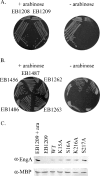Cooperative and critical roles for both G domains in the GTPase activity and cellular function of ribosome-associated Escherichia coli EngA
- PMID: 16963571
- PMCID: PMC1636305
- DOI: 10.1128/JB.00959-06
Cooperative and critical roles for both G domains in the GTPase activity and cellular function of ribosome-associated Escherichia coli EngA
Abstract
To probe the cellular phenotype and biochemical function associated with the G domains of Escherichia coli EngA (YfgK, Der), mutations were created in the phosphate binding loop of each. Neither an S16A nor an S217A variant of G domain 1 or 2, respectively, was able to support growth of an engA conditional null. Polysome profiles of EngA-depleted cells were significantly altered, and His(6)-EngA was found to cofractionate with the 50S ribosomal subunit. The variants were unable to complement the abnormal polysome profile and were furthermore significantly impacted with respect to in vitro GTPase activity. Together, these observations suggest that the G domains have a cooperative function in ribosome stability and/or biogenesis.
Figures



Similar articles
-
The tandem GTPase, Der, is essential for the biogenesis of 50S ribosomal subunits in Escherichia coli.Mol Microbiol. 2006 Sep;61(6):1660-72. doi: 10.1111/j.1365-2958.2006.05348.x. Epub 2006 Aug 23. Mol Microbiol. 2006. PMID: 16930151
-
Era and RbfA have overlapping function in ribosome biogenesis in Escherichia coli.J Mol Microbiol Biotechnol. 2006;11(1-2):41-52. doi: 10.1159/000092818. J Mol Microbiol Biotechnol. 2006. PMID: 16825789
-
Phenotypic investigations of the depletion of EngA in Escherichia coli are consistent with a role in ribosome biogenesis.FEMS Microbiol Lett. 2014 Apr;353(1):26-32. doi: 10.1111/1574-6968.12403. FEMS Microbiol Lett. 2014. PMID: 24822275 Free PMC article.
-
[Structure and function of 100S ribosome found in the stationary growth phase of Escherichia coli].Tanpakushitsu Kakusan Koso. 2006 Jul;51(8):966-71. Tanpakushitsu Kakusan Koso. 2006. PMID: 16838671 Review. Japanese. No abstract available.
-
Function of the universally conserved bacterial GTPases.Curr Opin Microbiol. 2003 Apr;6(2):135-9. doi: 10.1016/s1369-5274(03)00037-7. Curr Opin Microbiol. 2003. PMID: 12732302 Review.
Cited by
-
YphC and YsxC GTPases assist the maturation of the central protuberance, GTPase associated region and functional core of the 50S ribosomal subunit.Nucleic Acids Res. 2016 Sep 30;44(17):8442-55. doi: 10.1093/nar/gkw678. Epub 2016 Aug 2. Nucleic Acids Res. 2016. PMID: 27484475 Free PMC article.
-
The Photosystem II Repair Cycle Requires FtsH Turnover through the EngA GTPase.Plant Physiol. 2018 Oct;178(2):596-611. doi: 10.1104/pp.18.00652. Epub 2018 Aug 21. Plant Physiol. 2018. PMID: 30131421 Free PMC article.
-
DER containing two consecutive GTP-binding domains plays an essential role in chloroplast ribosomal RNA processing and ribosome biogenesis in higher plants.J Exp Bot. 2014 Jan;65(1):117-30. doi: 10.1093/jxb/ert360. Epub 2013 Nov 23. J Exp Bot. 2014. PMID: 24272962 Free PMC article.
-
Interactions of an essential Bacillus subtilis GTPase, YsxC, with ribosomes.J Bacteriol. 2008 Jan;190(2):681-90. doi: 10.1128/JB.01193-07. Epub 2007 Nov 2. J Bacteriol. 2008. PMID: 17981968 Free PMC article.
-
Nuclear/nucleolar GTPase 2 proteins as a subfamily of YlqF/YawG GTPases function in pre-60S ribosomal subunit maturation of mono- and dicotyledonous plants.J Biol Chem. 2011 Mar 11;286(10):8620-8632. doi: 10.1074/jbc.M110.200816. Epub 2011 Jan 4. J Biol Chem. 2011. PMID: 21205822 Free PMC article.
References
-
- Altschul, S. F., W. Gish, W. Miller, E. W. Myers, and D. J. Lipman. 1990. Basic local alignment search tool. J. Mol. Biol. 215:403-410. - PubMed
-
- Badurina, D. S., M. Zolli-Juran, and E. D. Brown. 2003. CTP:glycerol 3-phosphate cytidylyltransferase (TarD) from Staphylococcus aureus catalyzes the cytidylyl transfer via an ordered Bi-Bi reaction mechanism with micromolar Km values. Biochim. Biophys. Acta 1646:196-206. - PubMed
-
- Bochner, B. R., and B. N. Ames. 1982. Complete analysis of cellular nucleotides by two-dimensional thin layer chromatography. J. Biol. Chem. 257:9759-9769. - PubMed
-
- Bourne, H. R., D. A. Sanders, and F. McCormick. 1991. The GTPase superfamily: conserved structure and molecular mechanism. Nature 349:117-127. - PubMed
-
- Brown, E. D. 2005. Conserved P-loop GTPases of unknown function in bacteria: an emerging and vital ensemble in bacterial physiology. Biochem. Cell Biol. 83:738-746. - PubMed
Publication types
MeSH terms
Substances
LinkOut - more resources
Full Text Sources
Molecular Biology Databases

